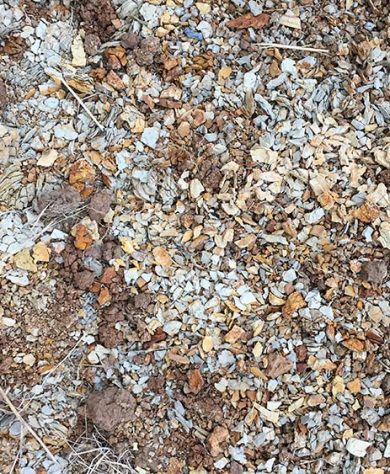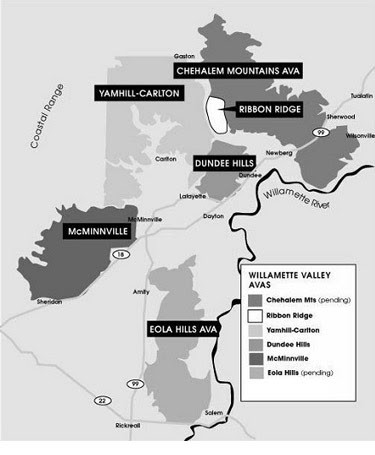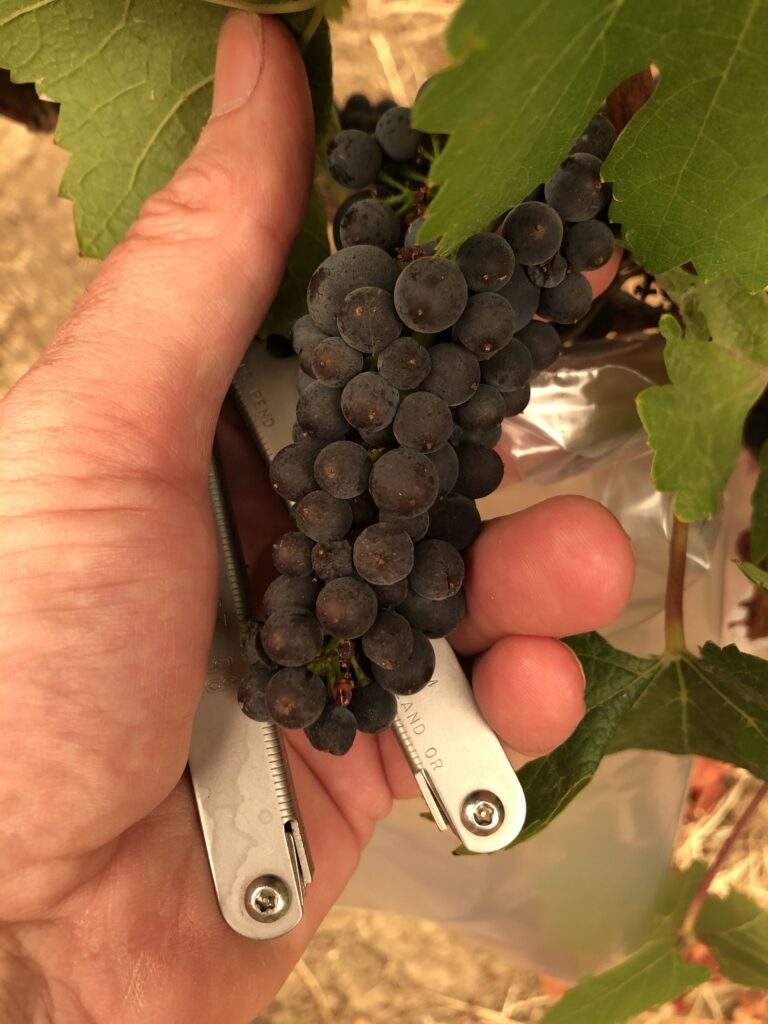Discover
The Root of The Matter
Wine quality starts in the vineyard.
The site is everything and the farming a parallel. Finding that right site to ultimately own and “put down roots” is time consuming and can be heartbreaking. After a long search, I was lucky enough to find an entire hill for my vineyard, offering every exposure and containing innumerable soil types. Over my first ten years making wine, I used grapes from over 15 different vineyards, learning a lot: exposure, elevation, clone type, planting, and management all effect the flavor of grapes. But one of the biggest factors, the one I focused on in choosing a site for my own vineyard, is the soils.

classic Willakenzie soil at Saffron Fields Vineyard
Digging to Discover
After a long search, in spring of 2005, I found a possible vineyard site.
The list of requirements for any potential property is limitless, as are the variables in making wine, but first and foremost the site had to be plant-able. After a soil test revealed that this location contained over twenty distinct and defined soils types, each uniquely suited for planting Pinot Noir and Chardonnay, I knew that I had found the perfect site.
I asked Joel Myers, who started back in the 1960’s with David Lett to walk the land, and give me an assessment. Joel has a vineyard management company named Vine Tenders and a long and respected history in the Willamette Valley having planted a large percentage and managing many of Oregon’s finest vineyards today. He also was instrumental in an opportunity to find out more about my vineyard site.
The timing was right as members of the US Geological Survey were in the area, re-mapping the soils of the Willamette. Various vineyard development people knew I was looking at this piece of property and asked about digging additional holes on the property. Andy Gallagher of Red Hills Soils had assessed the close to approximately one hundred holes I had dug on the property and found some odd soil types. When the new holes were dug, Dave Johnson of the USGS found soils present which were not known to be in the Yamhill-Carlton AVA.
The USGC researchers were confounded by the soils of my land. USGC researcher Dave Johnson found a dozen different soils – some were just not supposed to be found in the Yamhill-Carlton AVA.
Discover
The Root of The Matter
Wine quality starts in the vineyard.
The site is everything and the farming a parallel. Finding that right site to ultimately own and “put down roots” is time consuming and can be heartbreaking. After a long search, I was lucky enough to find an entire hill for my vineyard, offering every exposure and containing innumerable soil types. Over my first ten years making wine, I used grapes from over 15 different vineyards, learning a lot: exposure, elevation, clone type, planting, and management all effect the flavor of grapes. But one of the biggest factors, the one I focused on in choosing a site for my own vineyard, is the soils.



classic Willakenzie soil at Saffron Fields Vineyard
Digging to Discover
After a long search, in spring of 2005, I found a possible vineyard site.
The list of requirements for any potential property is limitless, as are the variables in making wine, but first and foremost the site had to be plant-able. After a soil test revealed that this location contained over twenty distinct and defined soils types, each uniquely suited for planting Pinot Noir and Chardonnay, I knew that I had found the perfect site.
I asked Joel Myers, who started back in the 1960’s with David Lett to walk the land, and give me an assessment. Joel has a vineyard management company named Vine Tenders and a long and respected history in the Willamette Valley having planted a large percentage and managing many of Oregon’s finest vineyards today. He also was instrumental in an opportunity to find out more about my vineyard site.
The timing was right as members of the US Geological Survey were in the area, re-mapping the soils of the Willamette. Various vineyard development people knew I was looking at this piece of property and asked about digging additional holes on the property. Andy Gallagher of Red Hills Soils had assessed the close to approximately one hundred holes I had dug on the property and found some odd soil types. When the new holes were dug, Dave Johnson of the USGS found soils present which were not known to be in the Yamhill-Carlton AVA.
The USGC researchers were confounded by the soils of my land. USGC researcher Dave Johnson found a dozen different soils – some were just not supposed to be found in the Yamhill-Carlton AVA.
The list of requirements for any potential property is limitless, as are the variables in making wine, but first and foremost the site had to be plant-able. After a soil test revealed that this location contained over twenty distinct and defined soils types, each uniquely suited for planting Pinot Noir and Chardonnay, I knew that I had found the perfect site.
I asked Joel Myers, who started back in the 1960’s with David Lett to walk the land, and give me an assessment. Joel has a vineyard management company named Vine Tenders and a long and respected history in the Willamette Valley having planted a large percentage and managing many of Oregon’s finest vineyards today. He also was instrumental in an opportunity to find out more about my vineyard site.
The timing was right as members of the US Geological Survey were in the area, re-mapping the soils of the Willamette. Various vineyard development people knew I was looking at this piece of property and asked about digging additional holes on the property. Andy Gallagher of Red Hills Soils had assessed the close to approximately one hundred holes I had dug on the property and found some odd soil types. When the new holes were dug, Dave Johnson of the USGS found soils present which were not known to be in the Yamhill-Carlton AVA.
The USGC researchers were confounded by the soils of my land. USGC researcher Dave Johnson found a dozen different soils – some were just not supposed to be found in the Yamhill-Carlton AVA.
Vineyard Designates
OREGON SOILS
There are over 800 different soil series in Oregon, of which only 92 have to date been utilized to grow grapes. Soil series are broken down into 25 different groups based upon common characteristics, but naming of the soils can differ by state.
For example; Oregon has Jory soil which has a high clay content, while this might be characteristically similar to a soil in Upstate New York, it would have a completely different name. This illustrates that the naming scheme is meaningless and that attention should be paid to each soil groups distinctive combination of parent material, topography, climate, vegetation, and history and how this will influence vine growth and the resulting fruit.
EIEIO & Company’s winegrowing philosophy is terroir based, but terroir is not JUST limited to soil.
For example; Oregon has Jory soil which has a high clay content, while this might be characteristically similar to a soil in Upstate New York, it would have a completely different name. This illustrates that the naming scheme is meaningless and that attention should be paid to each soil groups distinctive combination of parent material, topography, climate, vegetation, and history and how this will influence vine growth and the resulting fruit.
EIEIO & Company’s winegrowing philosophy is terroir based, but terroir is not JUST limited to soil.



I believe that it also has to do with the flora surrounding the area, the pollen from other plants which might affect the grape vine, wind (as I’ve seen with the thicker skinned fruit of the Meredith Mitchell Vineyard), etc. I also believe that the winery and cellar are part of “terroir” since the yeasts, microbes and molds in both will affect the wine. I can go on forever.
Pinot noir and Chardonnay are uniquely suited for terroir driven wine growing since these varietals lack genius when planted on average sites. For this reason, EIEIO & Company carefully selects its vineyards to produce wines that are not only reflective of that specific site, but are also, collectively, a representation of the Willamette Valley.



FARMING
After being in and around the vineyards of the Willamette Valley and having tasted the subsequent wine produced from them over the past 15 yrs, I’ve found that no hard and fast rules apply. You read, hear, and see people going on about yield, trellising, farming techniques and trendy pseudo-scientific farming methods.
What it really comes down to is this: Does the vineyard site produce a crop with personality? There are some who will only farm Bio dynamically, but is the end product always better and is the consumer willing to pay the additional costs associated with this method?
There are others who follow the DuPont philosophy of “Better living through chemistry” as it is a much easier approach to farming. We believe in finding a happy medium where we are farming sustainably without losing the unique characteristics of the specific site.
What it really comes down to is this: Does the vineyard site produce a crop with personality? There are some who will only farm Bio dynamically, but is the end product always better and is the consumer willing to pay the additional costs associated with this method?
There are others who follow the DuPont philosophy of “Better living through chemistry” as it is a much easier approach to farming. We believe in finding a happy medium where we are farming sustainably without losing the unique characteristics of the specific site.
Looking over the vineyards I lease, each one has a distinct personality in exposure, age, farming and the subsequent wine from it. With this vast array of personalities, I can choose to either blend forming the Cuvees “E”, “I” and at times the elusive “O” or, if the vineyard is impressive enough as a standalone, produce a single vineyard or even a single block bottling.
Each farmer has their own philosophy on how to farm their property. Most have been farming their property for at least 10 years and have learned not only what the plants want, but also what the site needs. While the vineyards in the current EIEIO & Company portfolio have farming practices unique to that specific site, the overall philosophy aligns nicely with my vision. They do what they do and I do with it what I do, in an attempt to produce better wines.
Vineyard Designates
OREGON SOILS
There are over 800 different soil series in Oregon, of which only 92 have to date been utilized to grow grapes. Soil series are broken down into 25 different groups based upon common characteristics, but naming of the soils can differ by state.
For example; Oregon has Jory soil which has a high clay content, while this might be characteristically similar to a soil in Upstate New York, it would have a completely different name. This illustrates that the naming scheme is meaningless and that attention should be paid to each soil groups distinctive combination of parent material, topography, climate, vegetation, and history and how this will influence vine growth and the resulting fruit.
EIEIO & Company’s winegrowing philosophy is terroir based, but terroir is not JUST limited to soil.
For example; Oregon has Jory soil which has a high clay content, while this might be characteristically similar to a soil in Upstate New York, it would have a completely different name. This illustrates that the naming scheme is meaningless and that attention should be paid to each soil groups distinctive combination of parent material, topography, climate, vegetation, and history and how this will influence vine growth and the resulting fruit.
EIEIO & Company’s winegrowing philosophy is terroir based, but terroir is not JUST limited to soil.
I believe that it also has to do with the flora surrounding the area, the pollen from other plants which might affect the grape vine, wind (as I’ve seen with the thicker skinned fruit of the Meredith Mitchell Vineyard), etc. I also believe that the winery and cellar are part of “terroir” since the yeasts, microbes and molds in both will affect the wine. I can go on forever.
Pinot noir and Chardonnay are uniquely suited for terroir driven wine growing since these varietals lack genius when planted on average sites. For this reason, EIEIO & Company carefully selects its vineyards to produce wines that are not only reflective of that specific site, but are also, collectively, a representation of the Willamette Valley.
Pinot noir and Chardonnay are uniquely suited for terroir driven wine growing since these varietals lack genius when planted on average sites. For this reason, EIEIO & Company carefully selects its vineyards to produce wines that are not only reflective of that specific site, but are also, collectively, a representation of the Willamette Valley.






FARMING
After being in and around the vineyards of the Willamette Valley and having tasted the subsequent wine produced from them over the past 15 yrs, I’ve found that no hard and fast rules apply. You read, hear, and see people going on about yield, trellising, farming techniques and trendy pseudo-scientific farming methods.
What it really comes down to is this: Does the vineyard site produce a crop with personality? There are some who will only farm Bio dynamically, but is the end product always better and is the consumer willing to pay the additional costs associated with this method?
There are others who follow the DuPont philosophy of “Better living through chemistry” as it is a much easier approach to farming. We believe in finding a happy medium where we are farming sustainably without losing the unique characteristics of the specific site.
What it really comes down to is this: Does the vineyard site produce a crop with personality? There are some who will only farm Bio dynamically, but is the end product always better and is the consumer willing to pay the additional costs associated with this method?
There are others who follow the DuPont philosophy of “Better living through chemistry” as it is a much easier approach to farming. We believe in finding a happy medium where we are farming sustainably without losing the unique characteristics of the specific site.
Looking over the vineyards I lease, each one has a distinct personality in exposure, age, farming and the subsequent wine from it. With this vast array of personalities, I can choose to either blend forming the Cuvees “E”, “I” and at times the elusive “O” or, if the vineyard is impressive enough as a standalone, produce a single vineyard or even a single block bottling.
Each farmer has their own philosophy on how to farm their property. Most have been farming their property for at least 10 years and have learned not only what the plants want, but also what the site needs. While the vineyards in the current EIEIO & Company portfolio have farming practices unique to that specific site, the overall philosophy aligns nicely with my vision. They do what they do and I do with it what I do, in an attempt to produce better wines.
Each farmer has their own philosophy on how to farm their property. Most have been farming their property for at least 10 years and have learned not only what the plants want, but also what the site needs. While the vineyards in the current EIEIO & Company portfolio have farming practices unique to that specific site, the overall philosophy aligns nicely with my vision. They do what they do and I do with it what I do, in an attempt to produce better wines.

